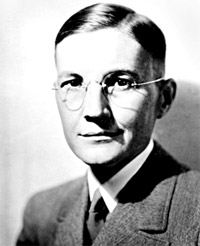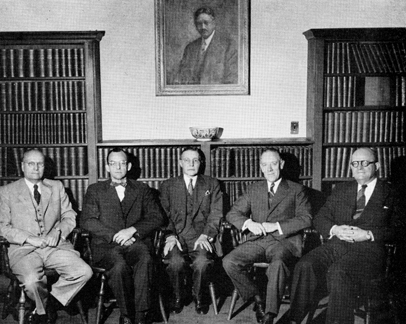Foundations of Neurophysiology: Characterizing the Electrical Properties of Nerves

Gasser, Herbert
Courtesy of The Rockefeller Archive Center
Nerve cells communicate by electrical impulses carried from one cell to the next along long projections called axons, or nerve fibers. Early in the twentieth century, Herbert Gasser (1888-1963), who was head of the Rockefeller Institute from 1935 to 1953, and Joseph Erlanger (1874-1965) proved that thick nerve fibers transmit signals faster than thin ones; they also showed that slowly conducting fibers mediate the perception of pain, whereas muscle reflexes and touch depend on fast-conducting fibers. In path-breaking research that was fundamental to the developing field of neurophysiology, they characterized a variety of additional properties of nerve cells. "For their discoveries relating to the highly differentiated functions of single nerve fibres," Gasser and Erlanger received the Nobel Prize in 1944.
Scientists had been investigating the electrical properties of nerves since the Italian physiologist Luigi Galvani noticed in 1771 that an electric shock given to a dead frog would make its muscles twitch. This discovery inspired Mary Shelly's novel Frankenstein, in which the monster is roused to life with an electric shock, nearly fifty years later. But the difficulty of working with exceedingly fine nerve cells (ranging in diameter from less than 0.001 mm to about 0.02 mm), and the minute electrical currents that activate them, delayed significant research for more than a century.
The necessary breakthrough was Dutch physician Willem Einthoven's invention of the string galvanometer in 1901, which allowed detection of very small electrical currents in animal tissue. That was the device used by Gasser and Erlanger as they began their research together at Washington University in 1916. Working on the frog sciatic nerve they soon recognized that the electric impulses they recorded were derived from a mixture of nerves, and over time they were able to identify three different types of nerve fibers, each with a characteristic type of impulse. Their research was dramatically enhanced in the early 1920s by adding a refined oscilloscope to their instrumentation, thus allowing them to trace the waves of electrical impulses traveling through the nerve fibers.

Simplified diagram of the electron oscillograph. From Electrical Signs of Nervous Activity, 1937
Neurophysiology became a major area of research at Rockefeller when Herbert Gasser succeeded Simon Flexner as head of the institute in 1935. By then he had a well-developed program in the electrophysiology of nerves, utilizing mammalian as well as frog nerves, for studies that illuminated fundamental properties of nerve cells, dendrites, and the primary synaptic endings of nerve fibers. His research at Rockefeller, carried on in collaboration with Harry Grundfest, established that laboratory studies of excised nerves could replicate the physiological conditions of nerves in living animals.
Gasser relied on ever-more sophisticated electronics, incorporating in his experimental apparatus advanced oscilloscopes made by RCA and both still and motion-picture photography, allowing him to create as many as six oscillographic records in the same experiment. To aid his research, Gasser greatly expanded the instrument shop that had been created at Rockefeller in 1920. This also allowed other Rockefeller scientists to develop new tools and new experimental approaches.
Herbert S. Gasser received the AB (1910) and AM (1911) from the University of Wisconsin, and the MD from the Johns Hopkins Medical School (1915). His life's work began when he joined Joseph Erlanger's laboratory at Washington University (St. Louis) in 1916, establishing their long and fruitful collaboration. During a leave of absence from 1923 to 1925 he worked with Archibald V. Hill (Nobel Prize, 1922) at University College, London, participating in the important British-American network of neuroscientists that flourished in the interwar era. This network was led by Edgar Adrian (Nobel Prize, 1932), Henry Dale (Nobel Prize, 1936), Hill, and Charles Sherrington (Nobel Prize, 1932), all of whom became connected with Rockefeller Institute through visiting fellowships and exchanges of students. In 1931 Gasser moved to Cornell University Medical College, where he was professor of physiology and head of the medical department. From 1935 to 1953 he served as director of the Rockefeller Institute. Beginning in 1936 he was for many years an editor of the Journal of Experimental Medicine. Gasser was elected a member of the U.S. National Academy of Sciences (1934) and the American Philosophical Society, and was a foreign member of several learned societies, including the Royal Society (London).

Herbert Gasser (center) was the second of six Professors of Physiology at the Cornell University Medical College. From Experimental Neurology, Suppl.1, 1964
Selected Publications
Gasser HS and Erlanger J. A study of the action currents of nerve with the cathode ray oscillograph. Am J Physiol, 1922, 62: 496-524
Erlanger J and Gasser HS. The compound nature of the action current in nerve as disclosed by the cathode ray oscillograph. Am J Physiol, 1924, 70: 624-666
Gasser HS and Erlanger J. The role played by the sizes of the constituent fibers of a nerve trunk in determining the form of the action potential wave. Am J Physiol, 1927, 80: 522-547
Gasser HS. Contractures of skeletal muscle. Physiol Rev, 1930, 10: 35-109
Erlanger J and Gasser HS. Electrical Signs of Nervous Activity. Eldridge Reeves Johnson Foundation for Medical Physics Lectures. Philadelphia: University of Pennsylvania Press, 1937
Further Reading
Chase MW and Hunt CC. Herbert Spencer Gasser, July 5, 1888-May 11, 1963: A Biographical Memoir. Washington, DC: US National Academy of Sciences, 1995, 67: 147-177
http://www.nasonline.org/site/PageServer?pagename=MEMOIRS_G
Gasser HS. Autobiography, with an introduction by Hinsey JC. Exp Neurol, 1964, 10(Suppl 1):1-38
Lloyd DPC. Herbert Spencer Gassser. In Gillespie CC, ed., Dictionary of Scientific Biography, vol 5. New York: Charles Scribners' Sons, 1981
Tierney A. Gasser, Bronk, and the international network of physiologists. In Stapleton DH, ed., Creating a Tradition of Biomedical Research New York: Rockefeller Univ Press, 2004
Schoenfeld RL. Explorers of the Nervous System: With Electronics and Institutional Base, a Network of Scientists. Boca Raton, FL: Universal Publishers, 2006
Links
The Nobel Prize in Medicine or Physiology, 1944 http://nobelprize.org/nobel_prizes/medicine/laureates/1944/
Herbert Gasser papers at the Rockefeller Archive Center http://www.rockarch.org/collections/ru/rgdescriptions.php
